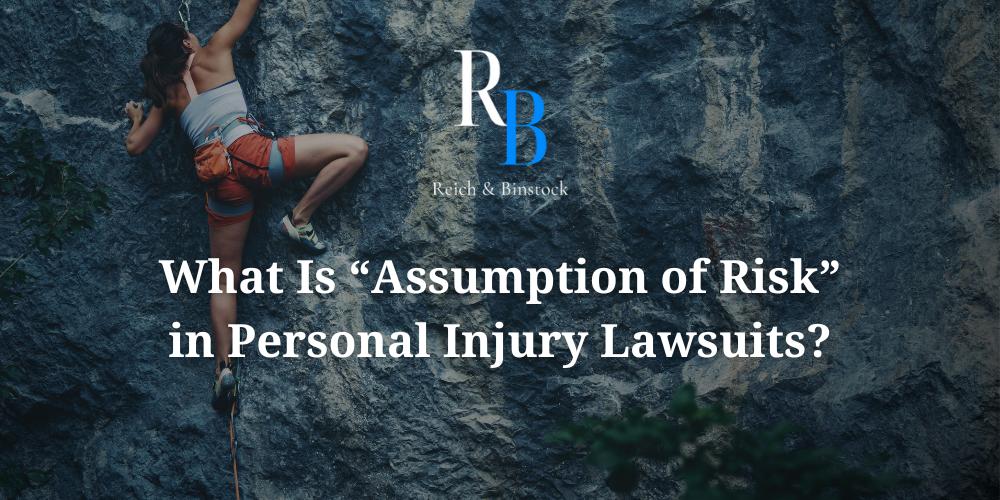Business owners and property owners have a legal duty to reasonably protect their patrons and visitors from harm. However, when people willingly engage in something they know can be dangerous, the only person liable for their injuries may be themselves. This is determined through what is called “assumption of risk.”
Assumption of risk is a defense that many organizations use to protect themselves from liability. Without the proper legal counsel, it can effectively squash a personal injury case. Below, we’ll take you through the different types of risk assumption, as well as how injury victims can fight against an assumption of risk defense and receive compensation.
If you have been injured in an accident while engaging in a risky activity, you’ll need an experienced personal injury attorney to help you win your case. The Houston personal injury lawyers at Reich & Binstock are prepared to fight for compensation on your behalf. Call us at (713) 622-7271 to schedule a free consultation with one of our injury experts.
What Is Assumption of Risk?
Assumption of risk is a legal doctrine that can protect a person or organization from liability in the event of personal injury. Imagine someone is hurt while engaging in an activity that is known to be risky. The injured party (also known as the plaintiff) could be fully responsible for their injuries. This only works, however, if the plaintiff assumed the risks of engaging in a particular activity through their words or actions.
For example, someone ignores a bright, yellow “wet floor” sign while walking in a store, and they slip and fall. The store owner may not be liable for the plaintiff’s injury since the plaintiff was knowingly engaging in something dangerous.
Types of Assumption of Risk

The assumption of risk doctrine is divided into two main types: express and assumed assumption of risk.
Express Assumption of Risk
Express assumption of risk applies to any situation in which a person engages in a risky activity but signs a written agreement to assume liability for their own injuries. Many dangerous activities require participants to sign a waiver or release form before they can participate. This protects others from liability.
Express Assumption of Risk Examples
One example of express assumption is when people sign a waiver when signing up for a gym membership. This protects the gym owners from liability if someone injures themselves while working out.
Implied Assumption of Risk

Implied assumption of risk applies to situations where a person engages in a dangerous activity, but they do not give express written consent. When someone engages in an activity that they know is dangerous, their actions can be used as a form of implied consent.
Implied Assumption of Risk Examples
One of the most commonly used examples of implied assumptions of risk is attending a baseball game. When someone goes to a baseball game, they accept the inherent risk that a foul ball could hit them. This form of assumption of risk prevents many people from receiving compensation for their injuries simply because they showed up and sat in the stands.
Primary and Secondary Assumption of Risk
Implied assumption of risk can be further classified as either primary or secondary assumption of risk. Primary assumption of risk occurs when someone engages in a risky activity when they know that no one else is responsible for their injuries. People who play contact sports have a high risk of injury. However, they are voluntarily participating in the sport. Therefore, they may be fully liable for any injuries they sustain while playing that sport.
Secondary assumptions of risk occurs when someone engages in a risky activity, but someone else is partially responsible for their safety. If someone goes bungee jumping, they are engaging in an activity that is inherently dangerous. However, the bungee jumping business that’s facilitating the activity has a responsibility to reasonably protect its patrons. If they don’t properly maintain and inspect their safety equipment, for example, they could be found partially liable in a personal injury claim.
Who is Legally Liable in an Assumption of Risk Case?

Liability in an assumption of risk case varies depending on the facts of the case and the circumstances surrounding the injury. In some cases, the person participating in the dangerous activity is legally liable for any injuries they sustain.
In many cases, however, the liability is split between the victim and other parties involved in the accident. This is decided through what is called comparative negligence. It plays a key role in how effective an assumption of risk defense is in a given case.
What is Comparative Negligence?
Comparative negligence is a legal doctrine that allows injury victims to sue other people for their injuries, even if they were partially at fault for their own injuries. For example, if a driver is t-boned by a car running a red light, but the victim was messing with the radio when they were hit, they could be found partially liable for the accident.
In states that use comparative negligence, liability in a personal injury case is split by percentage, and the damages awarded to the victim are reduced depending on their percent of liability. Using the above example, if the victim sued the driver who ran the red light, the court may decide that the victim was only 15% responsible for the accident. The victim would then be able to receive compensation for their injuries, but their payout would be reduced by 15% to account for their amount of fault.
Texas uses modified comparative negligence in personal injury cases. This allows victims of negligence to recover compensation as long as they are only 50% at fault or less. A victim who is 60% at fault for the accident cannot sue the other party in the accident for compensation.
How Do Comparative Negligence Laws Relate to Assumption of Risk?
Comparative negligence is often used in cases involving secondary assumptions of risk. In these kinds of accidents, both the victim and the defendant are partially responsible for the accident. However, the court has to determine the percentage of fault each side has. If the victim was more than 50% at fault for the accident, then they would be unable to recover compensation.
How Can an Assumption of Risk Defense Affect Your Personal Injury Case?
This doctrine can be used as a legal defense against claims of negligence. In personal injury cases, injury victims attempt to seek compensation for things like medical expenses from the person or organization responsible for their injuries, also known as the defendant. When the defendant uses an assumption of risk defense, it can decrease the amount of damages the victim can recover. This is because the victim assumes the inherent risks of engaging in a particular activity.
If you were injured while engaging in a dangerous activity, the defendant could use the assumption of risk defense. They do this to prove that you were entirely or mostly responsible for your injuries. This makes it impossible for you to recover damages. While assumption of risk can be an affirmative defense against a personal injury claim, there are exceptions to the rule. An experienced personal injury lawyer can help you argue that the defendant was mostly responsible for your injuries. This helps ensure that you can recover damages.
What Are Exceptions to the Rule?

Assumption of risk can be a valid defense against claims of negligence. However, it can’t be used as a complete defense against all claims of negligence. For assumption of risk to work as an affirmative defense, the risks involved in the accident had to be foreseeable. If someone went rock climbing and was hit by a falling rock, that would be considered a foreseeable risk. If they were hit by a car, however, that would not be considered a foreseeable or known risk.
Additionally, assumption of risk will not cover a defendant’s negligence if they behaved in a way that was intentionally harmful. If a zipliner purposefully tugs on the equipment to startle participants, they could be liable for injuries if someone falls.
Contact a Houston Personal Injury Lawyer with Reich & Binstock Today
While it’s possible to fight this defense, it’s important to have a strong legal team by your side to help. The Houston personal injury lawyers at Reich & Binstock can help ensure you are able to recover damages for your injuries. Call (713) 622-7271 or contact us online to schedule a free case evaluation with an experienced personal injury attorney today.














